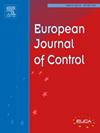高阶一致性:最优控制器设计
IF 2.6
3区 计算机科学
Q2 AUTOMATION & CONTROL SYSTEMS
引用次数: 0
摘要
本文研究了一种适用于多积分器智能体模型的高阶共识协议的优化设计。解决的问题相当于确定耦合增益的最优值和对网络建模的有向图的边权重。考虑到这一目标,提出了一个类似LQR的成本函数,它是通过对系统初始状态的期望从典型的LQR成本函数中获得的。为了实现优化算法,并最终解决所考虑的问题,首先需要解决成本及其衍生物的评估,同时考虑到共识问题的特殊性。然后,考虑截断牛顿法来确定高阶共识协议的最优参数。此外,提出了一种次优设计方法,该方法将问题分解为两个更简单的问题,在更短的时间内依次解决。还证明了如果考虑对称拉普拉斯矩阵,在初始条件的温和假设下,这些较简单的问题对于二阶和三阶一致是凸的。最后,通过实例说明了所提算法的有效性以及对控制器综合的好处。本文章由计算机程序翻译,如有差异,请以英文原文为准。
High-order consensus: Optimal controller design
This paper considers the optimal design of a high-order consensus protocol applied to agents modeled with multiple integrators. The problem addressed amounts to determining the optimal values for the coupling gains and for the edge weights of the directed graph that models the network. With that goal in mind, an LQR-like cost function is proposed, which is obtained from the typical LQR cost function by taking the expectation over the initial state of the system. To enable the implementation of optimization algorithms, and ultimately solve the considered problem, it is first necessary to tackle the evaluation of the cost and its derivatives, taking into account the particularities of the consensus problem. Then, to determine the optimal parameters of the high-order consensus protocol, a truncated Newton method is considered. Furthermore, a suboptimal design approach is proposed, which consists in splitting the problem into two simpler ones that are solved sequentially, in a reduced amount of time. It is also shown that if one considers symmetric Laplacian matrices, these simpler problems are convex for second- and third-order consensus under a mild assumption on the initial conditions. Finally, the proposed algorithms are illustrated with examples that demonstrate their efficacy as well as the benefits to the controller synthesis.
求助全文
通过发布文献求助,成功后即可免费获取论文全文。
去求助
来源期刊

European Journal of Control
工程技术-自动化与控制系统
CiteScore
5.80
自引率
5.90%
发文量
131
审稿时长
1 months
期刊介绍:
The European Control Association (EUCA) has among its objectives to promote the development of the discipline. Apart from the European Control Conferences, the European Journal of Control is the Association''s main channel for the dissemination of important contributions in the field.
The aim of the Journal is to publish high quality papers on the theory and practice of control and systems engineering.
The scope of the Journal will be wide and cover all aspects of the discipline including methodologies, techniques and applications.
Research in control and systems engineering is necessary to develop new concepts and tools which enhance our understanding and improve our ability to design and implement high performance control systems. Submitted papers should stress the practical motivations and relevance of their results.
The design and implementation of a successful control system requires the use of a range of techniques:
Modelling
Robustness Analysis
Identification
Optimization
Control Law Design
Numerical analysis
Fault Detection, and so on.
 求助内容:
求助内容: 应助结果提醒方式:
应助结果提醒方式:


